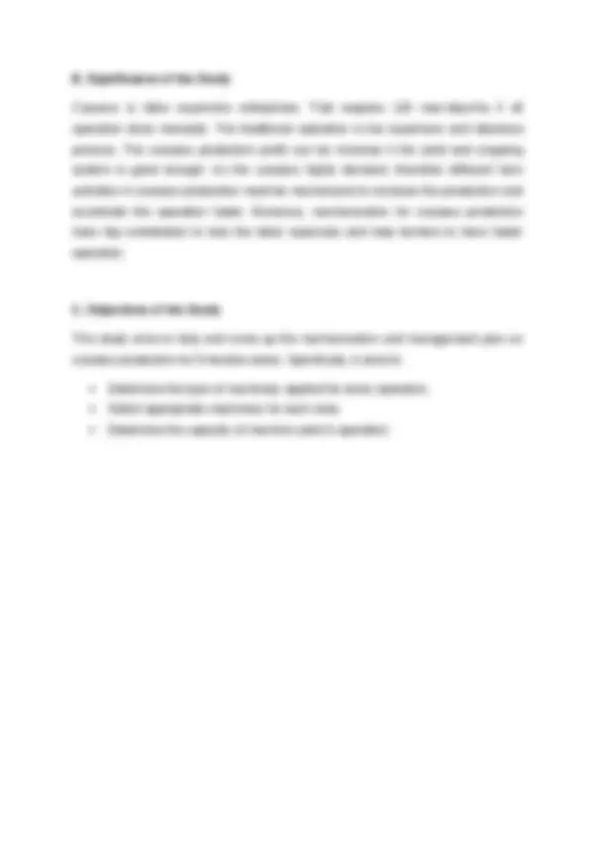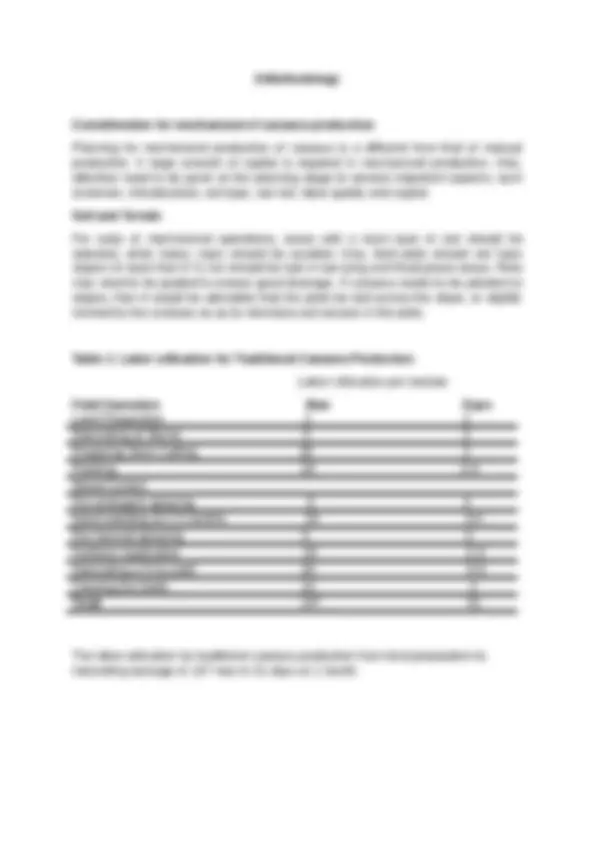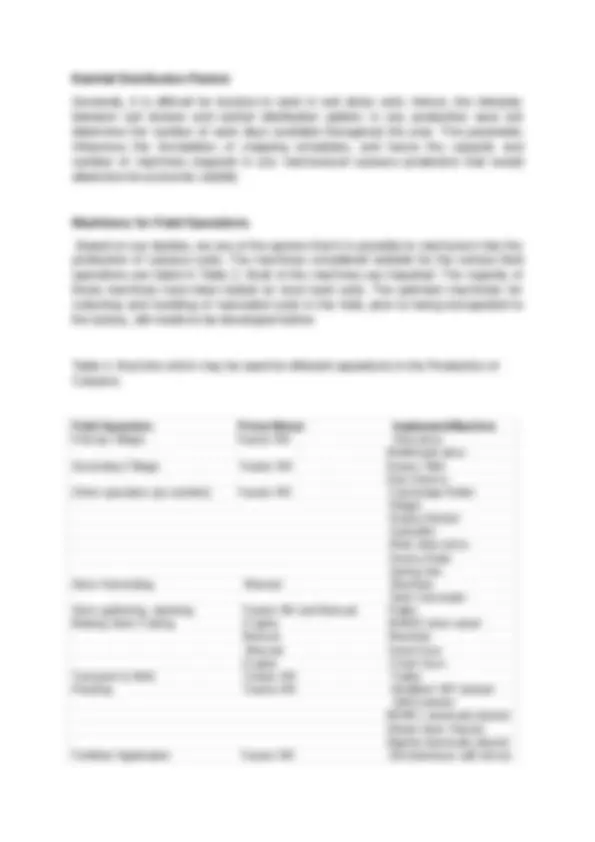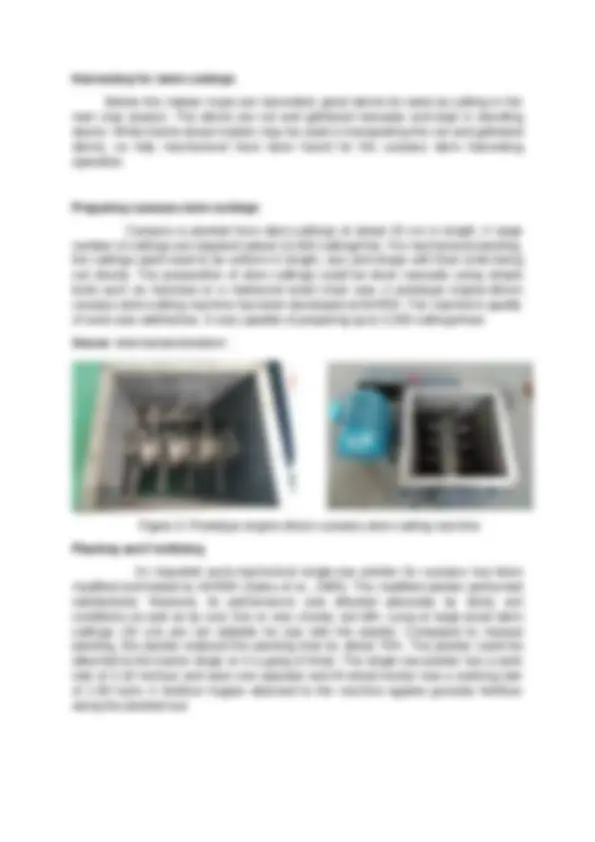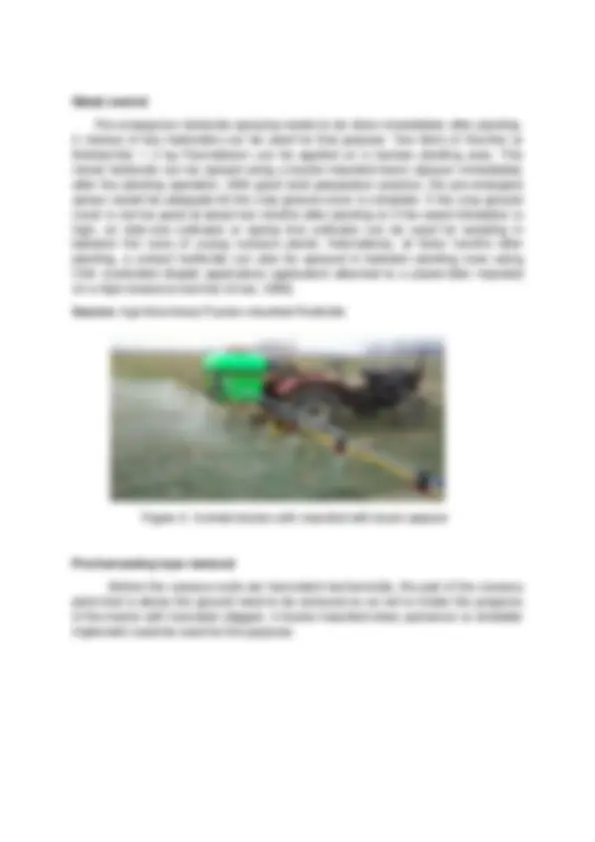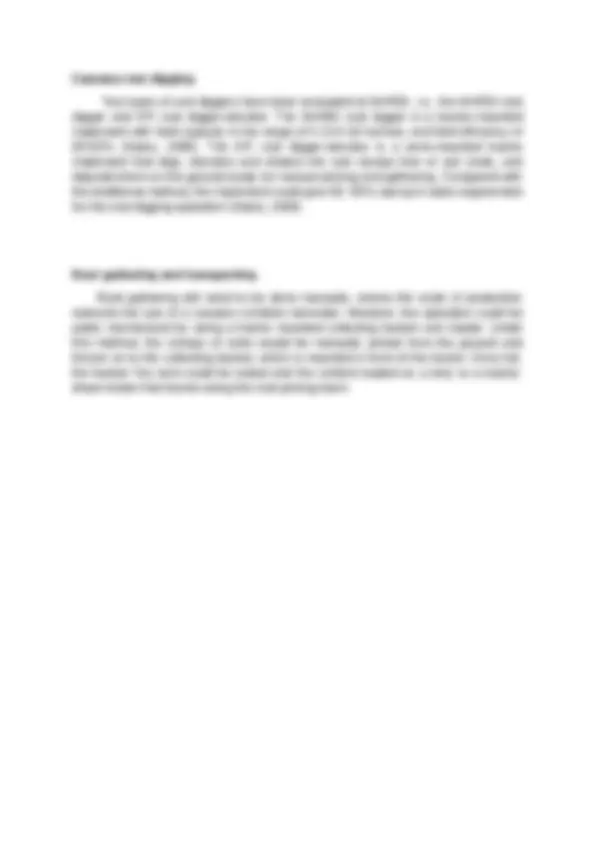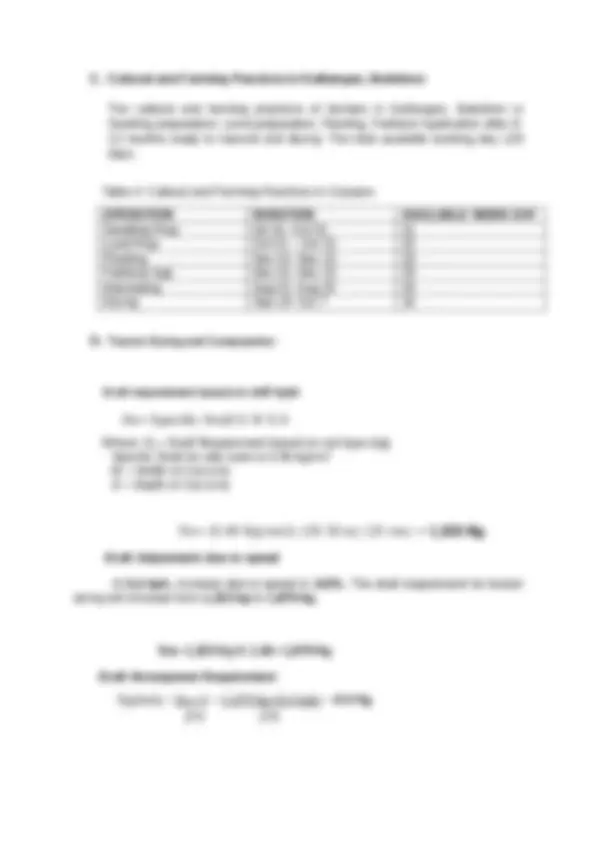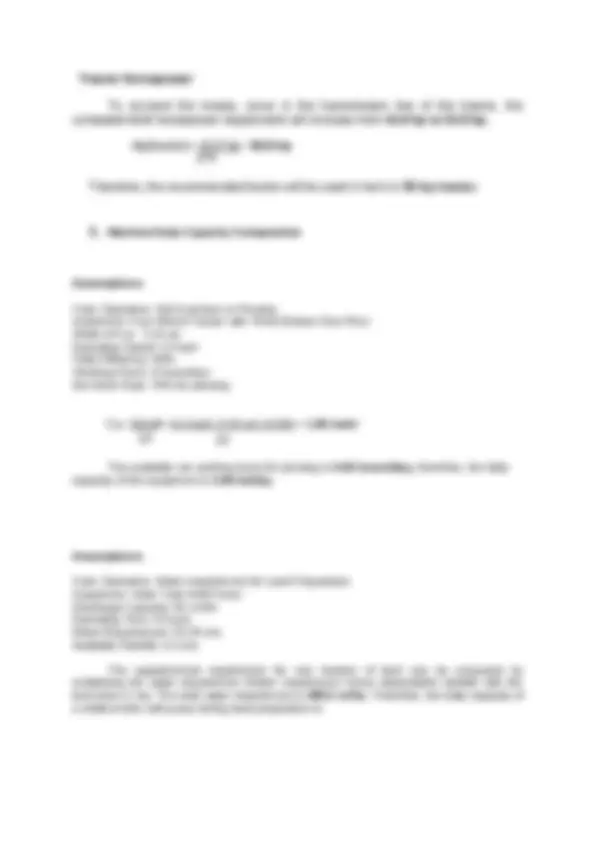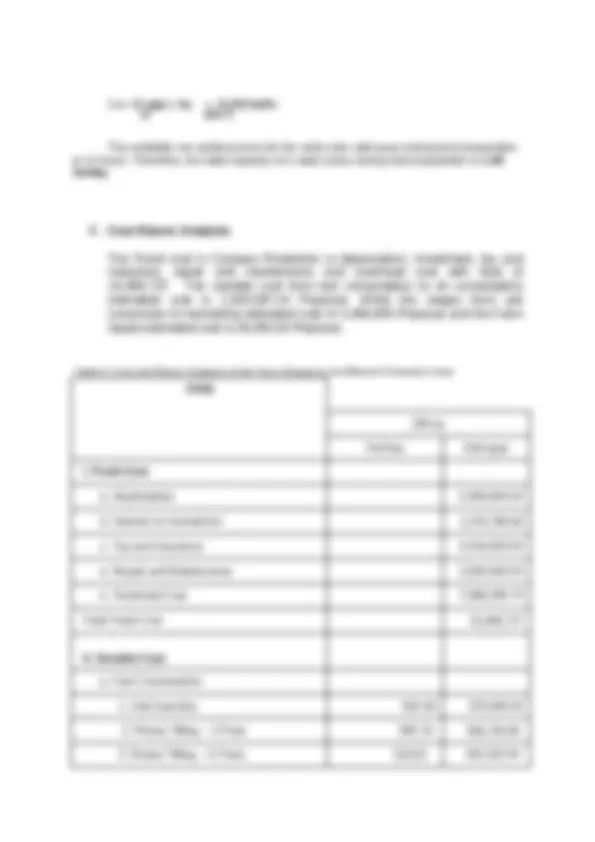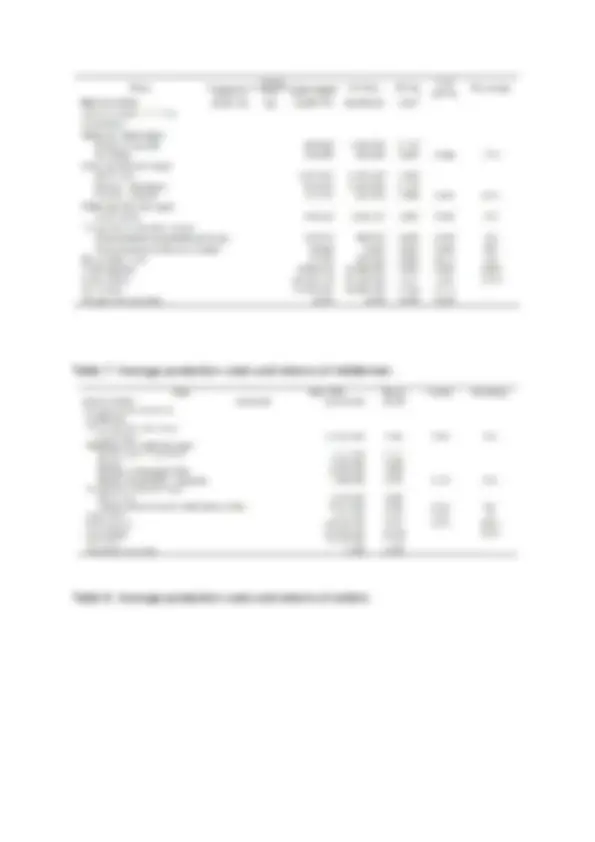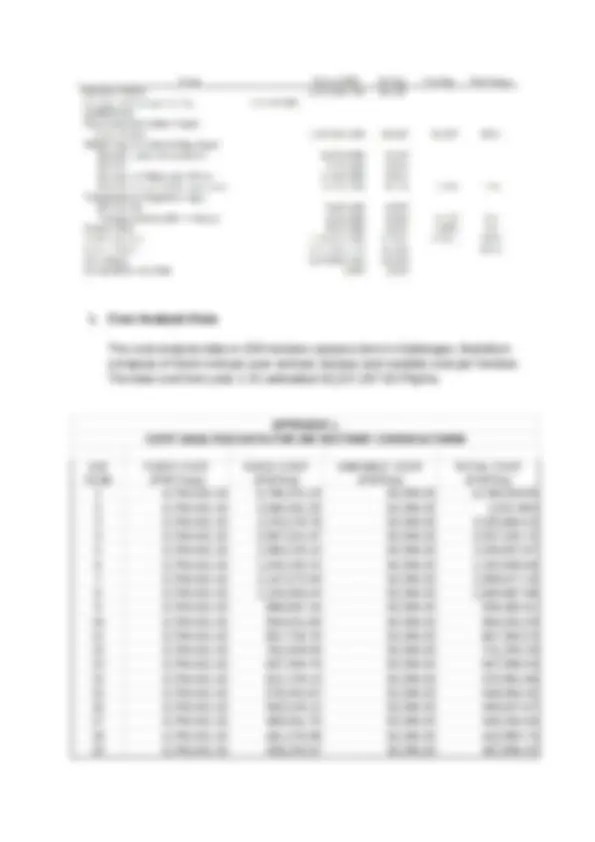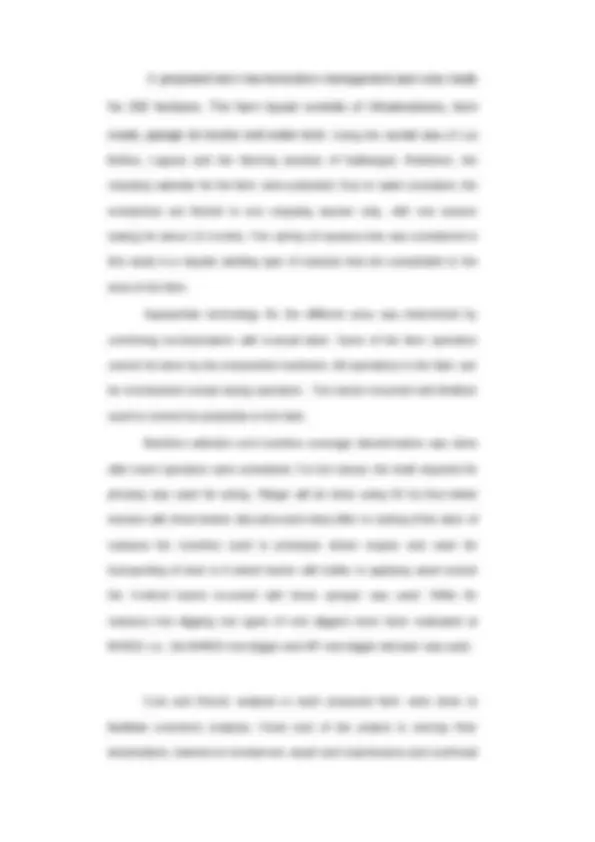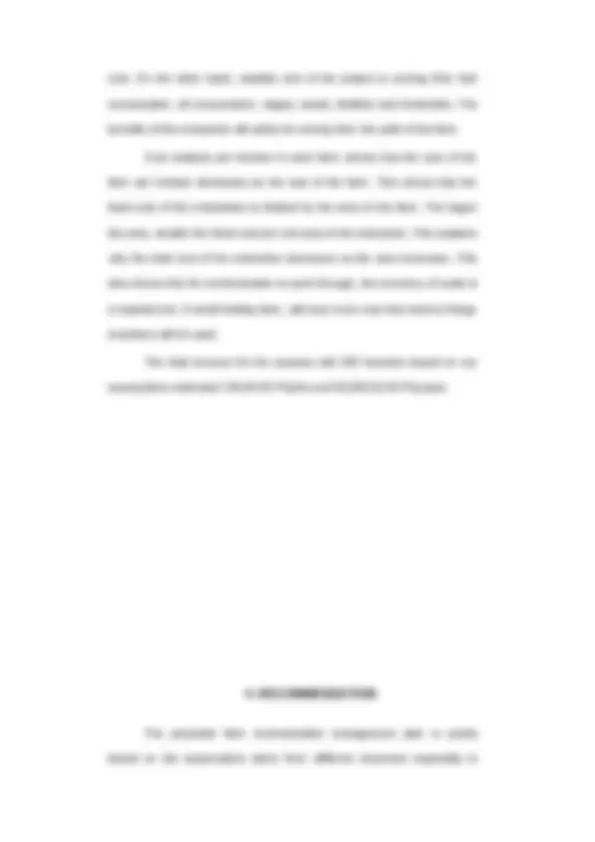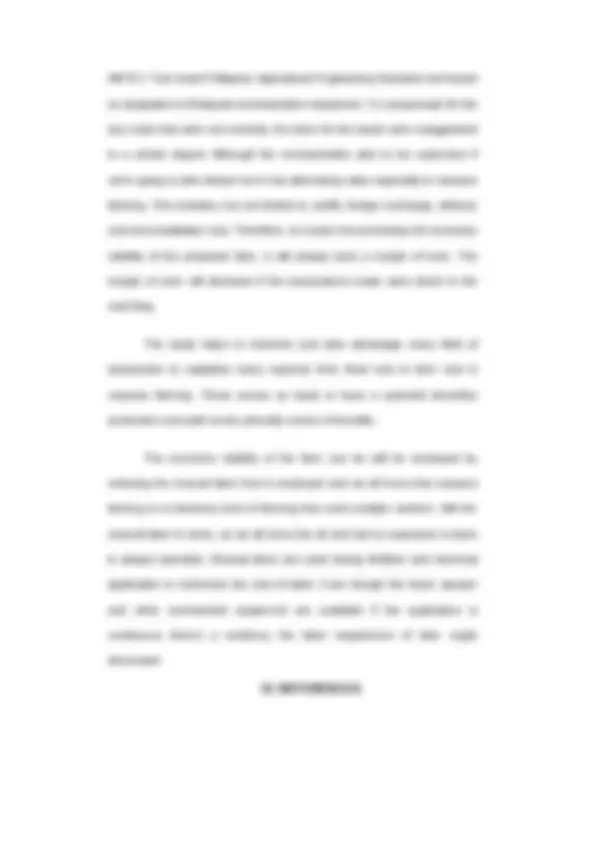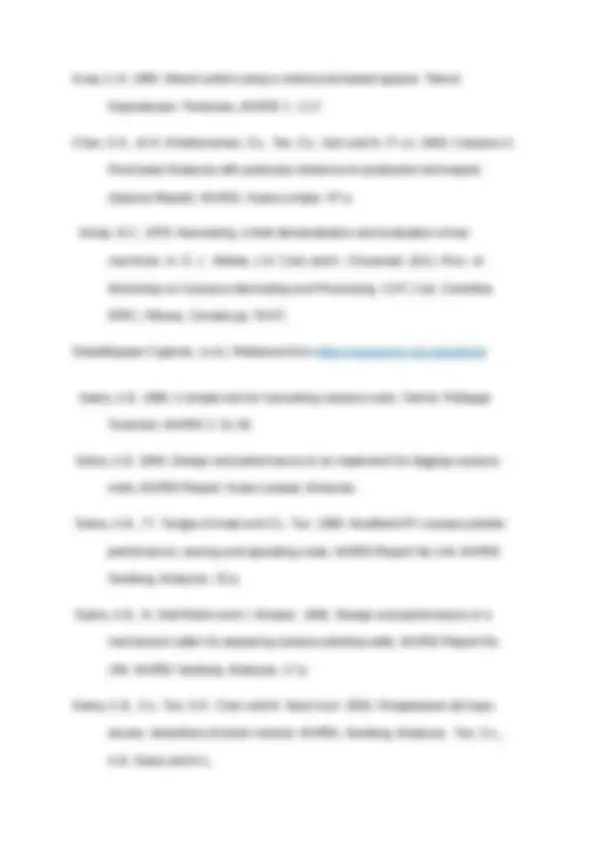Download Mechanizing Cassava Farming in the Philippines: A Study on Production and more Study Guides, Projects, Research Agricultural engineering in PDF only on Docsity!
MECHANIZATION PLAN OF CASSAVA PRODUCTION
IN KALILANGAN, BUKIDNON
JAY-AR CANCILLER
RANIEL KILAT
REMON PANANGIN
KIER VINCENT SEVILLEJO
JOSEPH WAMINAL
MAY 2023
I. Introduction
A. Rationale
Cassava ( Manihot esculenta ) is one of the most important root crops in the
Philippines because of its many uses. The total volume production for cassava is
2.61 million metric tons (PSA, Country stat). Aside from being used as food and feed
ingredients, cassava also used in the manufacture of industrial products. The
demand for cassava as raw material for industrial uses dramatically increased.
Cassava is planted each year about 120, 000 hectares of agricultural land in
Philippines, producing about 1.8 million of tons of cassava. (PSA)
Mechanization can increase productivity and profitability by reducing cost and
timeliness in operation. Mechanization in Bukidnon is limited only as machineries
very expensive, few farmers can afford to avail machineries those have large farm
area, even though government have support for the farmers especially The
Department of Agriculture (DA) the machinery is not sufficient to occupy to all
farmers. Mechanization plan especially for cassava is essential into large-scale
cassava production.
Machines for field operation for cassava, such as for land preparation, planting,
fertilizer application, weed control, harvesting and transportation have been
developed and reported (Sukra and Tan, 1994). In Bukidnon, mechanization for
cassava is currently limited to land preparation, herbicide spraying and digging of
roots. Mechanization for the other operations is needed for more cost-effective
commercial production of the crop in view labor shortage. The traditional method of
production is too labor and insensitive. It requires 120 man-days/ha.
II.Methodology
Consideration for mechanized of cassava production
Planning for mechanized production of cassava is a different from that of manual
production. A large amount of capital is required in mechanized production. Also,
attention need to be given at the planning stage to several important aspects, such
as terrain, infrastructure, soil type, rain fall, labor quality and capital.
Soil and Terrain
For ease of mechanized operations, areas with a loam type of soil should be
selected, while heavy clays should be avoided. Also, field plots should not have
slopes of more than 8 % nor should be laid in low-lying and flood-prone areas. Plots
may need to be graded to ensure good drainage. If cassava needs to be planted on
slopes, then it would be advisable that the plots be laid across the slope, or slightly
inclined to the contours so as to minimizes soil erosion in the plots.
Table 1: Labor utilization for Traditional Cassava Production
Labor Utilization per hectare
Field Operation Man Days
Land Preparation 2 2
Harvesting of Stems 5 2
Preparing Stem Cutting 20 2
Planting 20 3-
Weed Control
Pre-emergent spraying 5 3
Hand weeding at 2-3 months 20 3-
Pre-harvest spraying 5 3
Fertilizer Application 20 2-
Harvesting a 5-ha yield 30 5-
Clearing the fields 10 2
Total 147 31
The labor utilization for traditional cassava production from land preparation to
harvesting average of 147 man in 31 days or 1 month.
Rainfall Distribution Pattern
Generally, it is difficult for tractors to work in wet sticky soils. Hence, the interplay
between soil texture and rainfall distribution pattern in any production area will
determine the number of work days available throughout the year. This parameter
influences the formulation of cropping schedules, and hence the capacity and
number of machines required in any mechanized cassava production that would
determine its economic viability.
Machinery for Field Operations
Based on our studies, we are of the opinion that it is possible to mechanize fully the
production of cassava roots. The machines considered suitable for the various field
operations are listed in Table 2. Most of the machines are imported. The majority of
these machines have been tested on local loam soils. The optimum machinery for
collecting and handling of harvested roots in the field, prior to being transported to
the factory, still needs to be developed further.
Table 2. Machine which may be used for different operations in the Production of
Cassava.
Field Operation Prime Mover Implement/Machine Primary Tillage Tractor 4W Disc plow Moldboard plow Secondary Tillage Tractor 4W Rotary Tiller Disc Harrow Other operation (as needed) Tractor 4W Cambridge Roller Ridger Rotary Ditcher Subsoiler Mole drain plow Drump Rake Spring tine Stem Harvesting Manual Machete Stem Harvester Stem gathering, stacking Tractor 4W and Manual Trailer Making Stem Cutting Engine MARDI stem cutter Manual Machete Manual Hand Saw Engine Chain Saw Transport to field Tractor 4W Trailer Planting Tractor 4W Modified ‘API’ planter GMD planter BONEL automatic planter Whole Stem Planter Nigeria Automatic planter Fertilizer Application Tractor 4W Simultaneous with above
Land preparation Initial land clearing, land leveling and the field roads and drains can be done using standard machines or tractor implements such as 55 hp tractor with disc plow attachment and rotary tiller.
Figure 1: 4-wheel tractor with Disc-plow
Soil Cultivation
The implements to be chosen for cultivating the soil depend on the soil texture,
soil moisture status, ground slope, grass cover and other factors. Primary cultivation
can be done using a disk plow or moldboard plow. Secondary soil cultivation can be
done using a disk harrow or rotary tiller. Cambridge roller can be used for breaking
large soil clods or for compaction of over-loosened soil. On low ground areas with
possibility of flooding during heavy rains, planting on wide beds or high ridges is
recommended. Wide beds can be constructed using ridge or furrower implements.
However, it is better if such areas are provided with sufficient drainage to prevent
flooding.
Figure 2: 4-wheel tractor and Subsoiler
Harvesting for stem cuttings
Before the mature crops are harvested, good stems for used as cutting in the
next crop season. The stems are cut and gathered manually and kept in standing
stacks. While tractor-drawn trailers may be used in transporting the cut and gathered
stems, no fully mechanized have been found for the cassava stem harvesting
operation.
Preparing cassava stem cuttings
Cassava is planted from stem cuttings of about 20 cm in length. A large
number of cuttings are required (about 10,000 cuttings/ha). For mechanized planting,
the cuttings used need to be uniform in length, size and shape with their ends being
cut cleanly. The preparation of stem cuttings could be done manually using simple
tools such as hacksaw or a motorized small chain saw. A prototype engine-driven
cassava stem-cutting machine has been developed at MARDI. The machine’s quality
of work was satisfactory. It was capable of preparing up to 3,300 cuttings/hour.
Souce: starchprojectsolution
Figure 3: Prototype engine driven cassava stem cutting machine
Planting and Fertilizing
An imported semi-mechanical single-row planter for cassava has been
modified and tested by MARDI (Sukra et al., 1990). The modified planter performed
satisfactorily. However, its performance was affected adversely by sticky soil
conditions as well as by very fine or very chunky soil tilth. Long or large-sized stem
cuttings (19 cm) are not suitable for use with the planter. Compared to manual
planting, the planter reduced the planting time by about 70%. The planter could be
attached to the tractor singly or in a gang of three. The single row planter has a work
rate of 0.18 ha/hour and uses one operator and t4-wheel tractor was a working rate
of 1.85 ha/hr. A fertilizer hopper attached to the machine applies granular fertilizer
along the planted row.
Cassava root digging
Two types of root diggers have been evaluated at MARDI, i.e., the MARDI root
digger and API root digger-elevator. The MARDI root digger is a tractor-mounted
implement with field capacity in the range of 0.13-0.18 ha/hour, and field efficiency of
80-92% (Sukra, 1986). The API root digger-elevator is a semi-mounted tractor
implement that digs, elevates and shakes the root clumps free of soil clods, and
deposits them on the ground ready for manual picking and gathering. Compared with
the traditional method, the implement could give 92- 95% saving in labor requirement
for the root digging operation (Sukra, 1994)
Root gathering and transporting
Root gathering still need to be done manually, unless the scale of production
warrants the use of a cassava combine harvester. However, the operation could be
partly mechanized by using a tractor mounted collecting bucket cum loader. Under
this method, the clumps of roots would be manually picked from the ground and
thrown on to the collecting bucket, which is mounted in front of the tractor. Once full,
the bucket You sent could be raised and the content loaded on a lorry or a tractor-
drawn trailer that travels along the root picking team
III. RESULTS AND DISCUSSION
A. Farm Layout
The propose farm layout for the cassava production shown in Figure 5.
The dimension of the farm is 1000m X 2000m. The main office, cassava
warehouse, garage for tractors was placed in the front of farm. Since, the area
is too large they installed a shade for the tractors every 100 km that serve as
temporary house for tractors during operation. This is time to minimize the
travel time needed by the equipment to get to farm.
The farm has water tank for the water availability if there is a shortage of
water supply in the farm. The farm also has solar tube well pump used to
supply water to the farm.
The farm has also a good road network. The main road is in the side
portion of the infrastructure compound has 10 meters. These roads serve as
convenient way to have fast operation when going to farm.
Figure: 5 Perspective view of farm infrastructure
C. Cultural and Farming Practices in Kalilangan, Bukidnon
The cultural and farming practices of farmers in Kalilangan, Bukidnon is
Seeding preparation, Land preparation, Planting, Fertilizer Application after 8-
12 months ready to harvest and drying. The total available working day 129
days.
Table 4: Cultural and Farming Practices in Cassava
OPERATION DURATION AVAILABLE WORK DAY
Seedling Prep 0ct 01- Oct 31 21
Land Prep Oct 01 – Oct 31 22
Planting Nov 01- Nov 15 23
Fertilizer App Dec 01- Dec 15 23
Harvesting Aug 01- Aug 15 24
Drying Sep 19- Oct 7 16
D. Tractor Sizing and Computation
Draft requirement based on soil type
Ds= Specific Draft X W X D
Where: Ds = Draft Requirement based on soil type (kg)
Specific Draft for silty loam is 0.56 kg/cm^2
W = Width of Cut (cm)
D = Depth of Cut (cm)
Ds= (0.49 Kg/cm2) (3X 36 m) (25 cm) = 1,323 Kg
Draft Adjustment due to speed
At 6,4 kph, increase due to speed is 142%. The draft requirement for tractor
sizing will increase from 1,323 kg to 1,879 kg.
Da= 1,323 Kg X 1.42= 1,879 Kg
Draft Horsepower Requirement
Hp(draft) = Da x S = (1,879 Kg) (6,4 kph) = 43.9 Hp
Tractor Horsepower
To account the losses, occur in the transmission line of the tractor, the
computed draft horsepower requirement will increase from 43.9 hp to 54.9 hp.
Hp(tractor)= 43.9 hp= 54.9 hp
Therefore, the recommended tractor will be used in farm is 55 hp tractor.
E. Machine Daily Capacity Computation
Assumptions Farm Operation: Soil Inversion or Plowing Implement: Four Wheel Tractor with Three Bottom Disc Plow Width of Cut: 3.15 cm Operating Speed: 6.4 kph Field Efficiency: 89% Working Hours: 8 hours/day Net Work Rate: 70% for plowing Ca= SWeff= (6.4 kph) (3.25 cm) (0.89) = 1.85 ha/hr The available net working hours for plowing is 6.65 hours/day; therefore, the daily capacity of the equipment is 3.58 ha/day. Assumptions Farm Operation: Water requirement for Land Preparation Equipment: Solar Tube Well Pump Discharge Capacity: 65 m3/hr Operating Time: 8 hours Water Requirement: 55.25 mm Available Rainfall: 6.3 mm The supplemental requirement for one hectare of land can be computed by multiplying the water requirement (Water requirement minus dependable rainfall) with the land area (1 ha). The total water requirement is 489.5 m^3 /ha. Therefore, the daily capacity of a shallow tube well pump during land preparation is
b. Oil Consumption
III. Revenue a. Cassava Field 100,000.00 50,650,000.
G. Labor Requirement of the Cassava
Production Enterprise
The Labor Requirement of the Cassava
Production from soil inversion to harvesting
operation estimated 33 skilled and 53 unskilled.
Table 6. Number of Skilled and Unskilled Laborer in Every Farm Operation FARM OPERATION 200 ha Skilled Unskilled Soil Inversion 8 - Seedbed Preparation 8 Rotary Tilling – 1st^ Pass 10 Rotary Tilling – 2nd^ Pass 10 15 Fertilizer Application Transplanting Crop Protection (^20) Harvesting (^5 )
H. Economic Analysis of the Enterprise
The average production costs and return of cassava, production costs and
returns of middlemen and costs and returns of seller are shown in the table
6,7, and 8.
Table 6. Average production costs and returns of cassava farmers.
I. Cost Analysis Data
The cost analysis data in 200-hectare cassava farm in Kalilangan, Bukidnon
compose of fixed cost per year and per hectare and variable cost per hectare.
The total cost from year 1-31 estimated 32,227,247.63 Php/ha.
APPENDIX L
COST ANALYSIS DATA FOR 200 HECTARE CASSAVA FARM
HA/
YEAR
FIXED COST
(PhP/Year)
FIXED COST
(PhP/Ha)
VARIABLE COST
(PhP/Ha)
TOTAL COST
(PhP/Ha) 1 6,798,431.10 6,798,431.10 50,396.25 6,748,034. 2 6,798,431.10 3,598,361.25 50,396.25 3,547, 3 6,798,431.10 3,376,278.78 50,396.25 3,325,882. 4 6,798,431.10 2,987,501.97 50,396.25 2,937,105. 5 6,798,431.10 1,586,234.12 50,396.25 1,535,837. 6 6,798,431.10 1,243,345.31 50,396.25 1,192,949. 7 6,798,431.10 1,147,073.44 50,396.25 1,096,677. 8 6,798,431.10 1,120,084.23 50,396.25 1,069,687. 9 6,798,431.10 986,887.16 50,396.25 936,490. 10 6,798,431.10 954,651.84 50,396.25 904,255. 11 6,798,431.10 857,756.78 50,396.25 807,360. 12 6,798,431.10 781,694.59 50,396.25 731,294. 13 6,798,431.10 697,494.79 50,396.25 647,098. 14 6,798,431.10 621,378.13 50,396.25 570,981. 15 6,798,431.10 578,452.67 50,396.25 528,056. 16 6,798,431.10 500,034.12 50,396.25 449,637. 17 6,798,431.10 489,561.76 50,396.25 439,165. 18 6,798,431.10 461,376.98 50,396.25 410,980. 19 6,798,431.10 438,292.67 50,396.25 387,896.
IV. SUMMARY AND CONCLUSION
- 4. Fertilizer Application 502.78 190,900. - 5. Crop Protection 650.55 15, 300. - 6. Harvesting 670.20 205,440. - Subtotal 3,844.69 1,247,600. - 1. Soil Inversion 111.00 43,290. - 2. Rotary Tilling – 1st Pass 74.00 28,859. - 3. Rotary Tilling – 2nd Pass 61.67 24,049. - 5. Crop Protection 4.66 1,815. - 6. Harvesting 94.99 37,044. - Subtotal 723.04 281,986. - 1. Soil Inversion 3,000.00 800,000. c. Wages
- Seedbed Preparation 60.15 20,895.
- Rotary Tilling – 1st Pass 3,000.00 790,000.
- Rotary Tilling – 2nd Pass 3,000.00 790,000.
- Fertilizer Application 5,800.00 1,900,000.
- Crop Protection 1,780.00 670,000.
- Harvesting 4,200.00 900,000. - Subtotal 20,840.15 4,360, - 1. Seeds 900.00 950,00. d. Farm Inputs - 2. Fertilizer 20,500.00 20, 550,000. - 3. Herbicide 4,000.00 4,550,000. - Subtotal 15,600.00 26,050,000.
- 20 6,798,431.10 412,542.41 50,396.25 362,146.
- 21 6,798,431.10 394,723.39 50,396.25 344,327.
- 22 6,798,431.10 372,492.79 50,396.25 322,096.
- 23 6,798,431.10 351,367.15 50,396.25 300,970.
- 24 6,798,431.10 334,192.10 50,396.25 283,795.
- 25 6,798,431.10 326,347.49 50,396.25 275,951.
- 26 6,798,431.10 301,285.67 50,396.25 250,889.
- 27 6,798,431.10 298,865.85 50,396.25 248,469.
- 28 6,798,431.10 271,689.73 50,396.25 221,293.
- 29 6,798,431.10 264,479.64 50,396.25 214,083.
- 30 6,798,431.10 254,359.57 50,396.25 203,963.
- 31 6,798,431.10 243,307.91 50,396.25 192,911.

